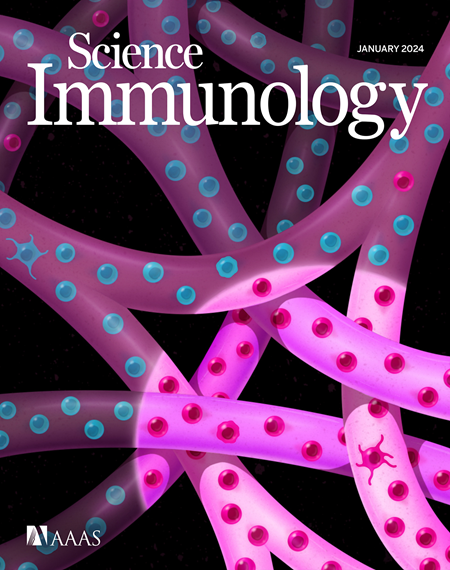Foxo1以解剖室和上下文特异性的方式调节肠组织驻留记忆CD8 T细胞生物学
IF 17.6
1区 医学
Q1 IMMUNOLOGY
引用次数: 0
摘要
组织驻留记忆CD8 T (TRM)细胞在屏障和粘膜组织中作为对抗微生物病原体的一线防御。准确预测调节TRM生物学的组织特异性转录因子(TFs)的作用仍然是一个挑战。在这里,通过整合转录组学和表观基因组学分析,我们发现叉头盒01 (Foxo1)在肠道TRM生物学中具有意想不到的作用,Foxo1是一种以前已知的调节循环记忆T细胞的TF。Foxo1抑制了早期小肠上皮内TRM细胞的维持,这与其维持小肠固有层和结肠TRM细胞的作用相反,也与其促进肠道TRM细胞形成的更广泛作用相反。这些发现强调了TRM细胞的转录调控可能比以前认识到的更复杂和微妙的新兴概念,并强调了整合转录组学和表观基因组学分析在重建tf调控网络中的实用性。本文章由计算机程序翻译,如有差异,请以英文原文为准。
Foxo1 regulates intestinal tissue–resident memory CD8 T cell biology in an anatomic compartment– and context-specific manner
Tissue-resident memory CD8 T (TRM) cells serve as a front-line defense against microbial pathogens in barrier and mucosal tissues. Accurately predicting the roles of tissue-specific transcription factors (TFs) that regulate TRM biology remains a challenge. Here, by applying integrated transcriptomic and epigenomic analyses, we have identified an unexpected role for forkhead box O1 (Foxo1), a TF previously known to regulate circulating memory T cells, in intestinal TRM biology. Foxo1 repressed the maintenance of early small intestinal intraepithelial TRM cells in contrast with its actions in sustaining TRM cells from small intestinal lamina propria and colon and contrary to its broader role in promoting intestinal TRM cell formation. These findings highlight the emerging concept that the transcriptional regulation of TRM cells may be more complex and nuanced than previously appreciated and underscore the utility of integrated transcriptomic and epigenomic analyses in reconstructing TF-regulatory networks.
求助全文
通过发布文献求助,成功后即可免费获取论文全文。
去求助
来源期刊

Science Immunology
Immunology and Microbiology-Immunology
CiteScore
32.90
自引率
2.00%
发文量
183
期刊介绍:
Science Immunology is a peer-reviewed journal that publishes original research articles in the field of immunology. The journal encourages the submission of research findings from all areas of immunology, including studies on innate and adaptive immunity, immune cell development and differentiation, immunogenomics, systems immunology, structural immunology, antigen presentation, immunometabolism, and mucosal immunology. Additionally, the journal covers research on immune contributions to health and disease, such as host defense, inflammation, cancer immunology, autoimmunity, allergy, transplantation, and immunodeficiency. Science Immunology maintains the same high-quality standard as other journals in the Science family and aims to facilitate understanding of the immune system by showcasing innovative advances in immunology research from all organisms and model systems, including humans.
 求助内容:
求助内容: 应助结果提醒方式:
应助结果提醒方式:


